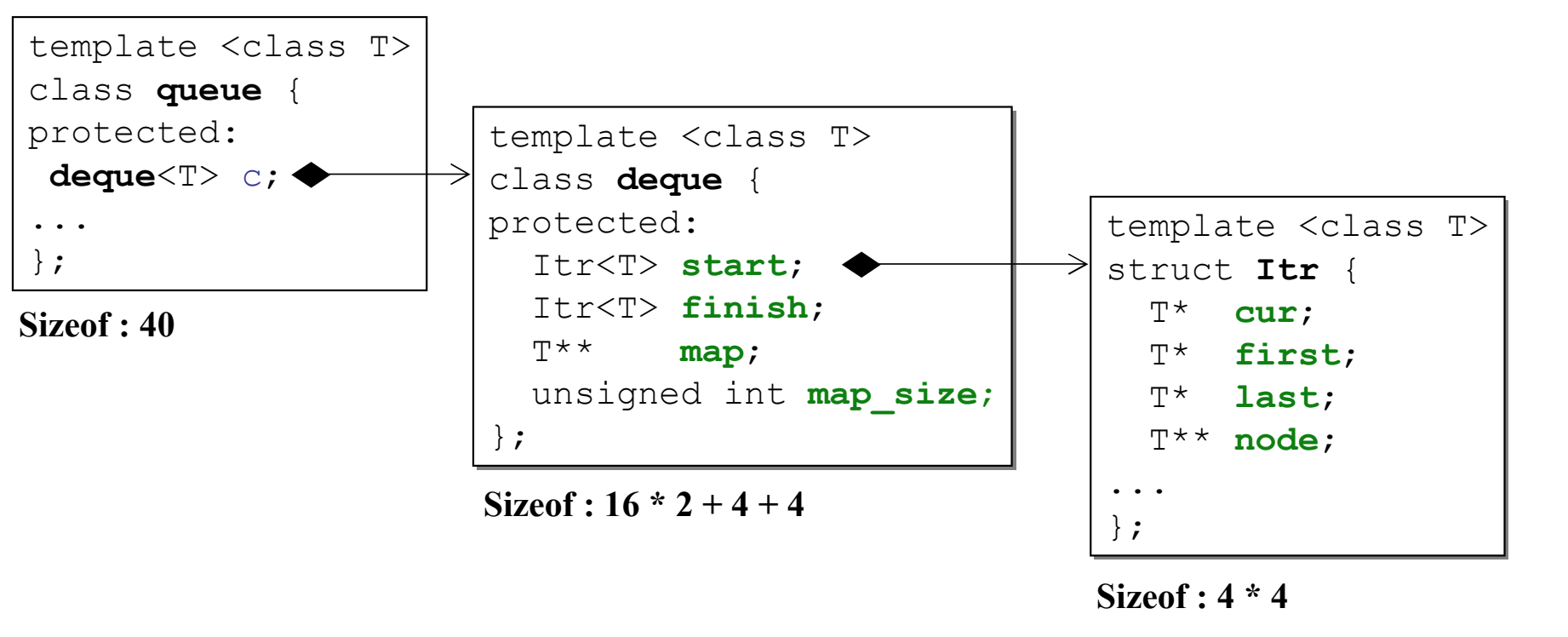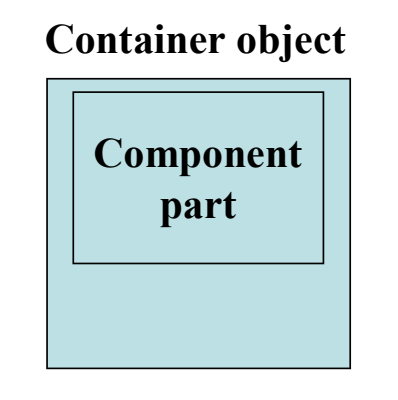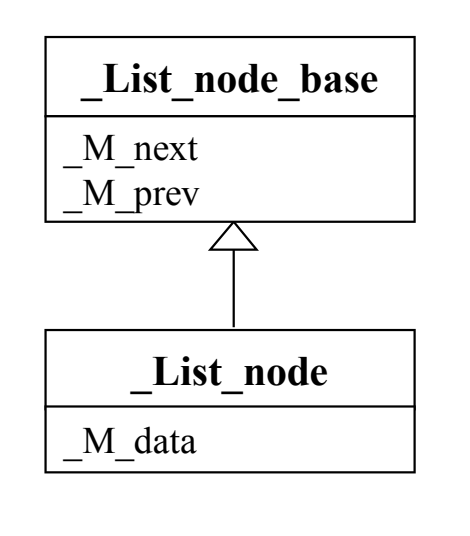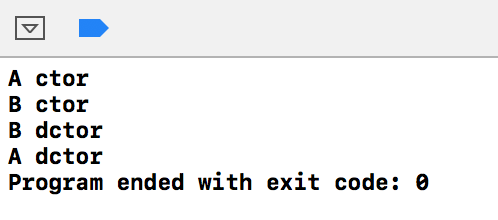技术在于交流、沟通,转载请注明出处并保持作品的完整性。
本节主要介绍一下类与类之间的关系,也就是面向对象编程先介绍两个术语
Object Oriented Programming OOP面向对象编程
Object Oriented Design OOD面向对象设计
对于类与类之间的关系有很多种,但是我认为理解3种足够
1.Inheritance (继承)
2.Composition (组合)
3.Delegation (委託) 该种关系也可以理解成聚合
一.组合
1.定义: has-a的关系,一个类中有包含另外一个类 (类中的成员变量之一是类),是包含一个对象,而不是包含一个指针,如果你组合了这个类,那么你就将拥有你包含的类的全部功能
下面我介绍一个组合的实际应用
#include<deque> #include <queue> template <class T> class queue { ... protected: std::deque<T> c; // 底層容器 has-a的关系 public: // 以下完全利用 c 的操作函數完成 bool empty() const { return c.empty(); }//利用deque的功能来实现queue新定义的功能 size_t size() const { return c.size(); } reference front() { return c.front(); } reference back() { return c.back(); } void push(const value_type& x) { c.push_back(x); } void pop() { c.pop_front(); } };
queue是一种队列操作,单方向操作先进先出
deque是两端都可进出,所以说deque的功能较强大与quque,但是如果我queue组合deque(包含 has-a)那么我们就可以利用deque的功能来实现queue新定义的功能
这就是组合关系的一种实际应用,同时它也是adapter设计模式
2.类图

那么上面的queue与deque的类图为
![]()
queue包含deque
3.内存管理
template <class T> class queue {
protected: deque<T> c; ... }; template <class T> class deque { protected: Itr<T> start; Itr<T> start;//16 bit Itr<T> finish; Itr<T> finish; //16 bit T** map; T** map; //4bit unsigned int map_size; //4bit }; template <class T> struct Itr { struct Itr { T* cur; T* cur; //4bit T* first; T* first; T* last; T* last; T** node; ... };
图示

所以是queue的内存为40bit
4.构造与析构
未了方便我们的理解,我们可以将组合关系联想成下图

a.构造由内而外
Container 的构造函数首先调用 Component 的 default 构造函数,然後才执行自己 的构造函数,可以理解成这样
Container::Container(...): Component() { ... };
b.析构由外而内
Container 的析构函数首先执行自己的,然后调用 Component 的 析构函数,可以理解成这样
Container::~Container(...){ ... ~Component() };
5.生命周期
Container于Component具有相同的生命周期
二.聚合 也就是委托关系
1.定义has-a pointer,一个类中包含另一个类的指针,你也同样拥有被包含类的全部功能,他有一个重要的使用方法handle/body(pImpl)(我在格式工厂(六)shared_ptr中有介绍)
class StringRep; class String {//handle public: String(); String(const char* s); String &operator=(const String& s); ~String(); .... private: StringRep* rep; // pimpl }; class StringRep { //body friend class String; StringRep(const char* s); ~StringRep(); int count; char* rep; };
功能其实与组合非常相似
2.类图
![]()
3.内存管理
包含一个指针 4bit
4.构造与析构
不发生影响
5.生命周期
生命周期可以不相同
三.继承
1.定义is-a的关系,分为父类(Base)和子类(Drived),可以理解成孩子继承父亲的财产,就是父类有的子类都可以有,也可以理解成子类有父类的成分
class _List_node_base { ... _List_node_base* _M_next; _List_node_base* _M_prev; ... }; template<typename _Tp> class _List_node: public _List_node_base { _Tp _M_data; };
2.类图

3.内存管理
无太大关联,抛去成员变量,子类比父类多一个虚函数表 4bit
4.构造与析构
子类含有父类的成分,可以理解成

构造由内而外
Derived 的构造函数首先调用Base 的 default 构造函数, 然后执行自己的
Derived::Derived(...): Base() { ... };
析构由外而内
Derived 的析构函数首先执行自己的,然后调用用 Base 的析构函数。
Derived::~Derived(...){ ... ~Base() };
5.继承真正的使用是与虚函数的搭配
虚函数:用virtual声明的函数,它有三种形式
non-virtual 即普通函数,你不希望子类重新定义它(重新定义override)
virtual 函数(虚函数):你希望 derived class 重新定义 它,且你对这个函数有默认定义
pure virtual 函数(纯虚函数):你希望 derived class 一定要重新定义它,你对它没有默认定义
void func_1();//non-virtual virtual void func_2();//virtual virtual void func_3() = 0;//pure virtual
下面我们来验证一下上面的继承规则
class A { public: A() { cout<< "A ctor" << endl; } virtual ~A() { cout<< "A dctor" << endl; } void func() { cout<< "A::func()"<<endl; } virtual void func_virtual() { cout<< "A::func_virtual()"<<endl; } }; class B : public A { public: B() { cout<< "B ctor"<<endl; } ~B() { cout<< "B dctor"<<endl; } void func_virtual() { cout<< "B::func_virtual()"<<endl; } };
我们先创建一个B对象看看都能输出什么
int main(int argc, const char * argv[]) { B b; return 0; }
输出结果

说明继承由内而外的构造,和由外而内的析构
继续看
1 int main(int argc, const char * argv[]) { 2 A* a = new B(); //父类指针可以指向子类对象(一般情况下子类的内存占用会大于父类,所以父类指针指向子类是可以的,那么反过来 子类指针指向父类就不行了) 3 a->func(); 4 a->func_virtual(); 5 delete a;//谁申请谁释放 6 a = nullptr; 7 return 0; 8 }
输出结果

你会返现为什么我用a调用func_virtual() 会调用到B的该函数,这个就是继承的好处之一了,他能动态识别是谁调用
用虚函数表来解释动态识别想必大家都会知道,现在我来介绍一下我的理解---this指针
在C++类中除了静态变量都有this指针,在上面第2行 A* a = new B(); 其实 a是一个b对象
在第3行 a->func(),编译器会编译成a->func(&a),(我在之前的文章中介绍过谁调用谁就是this,那么治理的&a 就相当于this),然后会在B中找func(),发现没有就去父类的A中去找
在第4行 a->func_virtual() => a->func_virtual(&a) 在B中找到了所以调用.
四 组合+继承
组合和继承共同使用它们的它们的创建顺序会是什么样子
第一种

Component构造 > Base构造 > 子类构造 析构相反
第二种

组合和继承的构造顺序都是由内而外,析构顺序都是由外而内,那上面的构造析构顺序呢
class A { public: A(){cout<< "A ctor" << endl;} virtual ~A(){cout<< "A dctor" << endl;} void func(){cout<< "A::func()"<<endl;} virtual void func_virtual(){cout<< "A::func_virtual()"<<endl;} }; class C { public: C(){cout<< "C ctor"<<endl;} ~C(){cout<< "C dctor"<<endl;} }; class B : public A { public: B(){cout<< "B ctor"<<endl;} ~B(){cout<< "B dctor"<<endl;} void func_virtual(){cout<< "B::func_virtual()"<<endl;} private: C c; };
输出结果

Base构造 > Component构造 > 子类构造 析构相反
Derived 的构造函数首先调用 Base 的 default 构造函数, 然后调用 Component 的 default 构造函数, 然后执行自己
Derived::Derived(...): Base(),Component() { ... };
Derived 的析构函数首先执行自己, 然后调用 Component 的 析构函数,然后調用 Base 的析构函数
Derived::~Derived(...){ ... ~Component(), ~Base() };
五 聚合 + 继承
这个我用一种设计模式来做实例
观察者模式(主要介绍聚合+继承的实现,详细的观察者模式我会在设计模式中介绍)
假设有一个txt文件,我用三个不同的阅读软件同时读取这一个txt文件,那么当txt内容发生改变时,这三个阅读器的内容都应做出相应的变化,其实现代码大致如下
用类图描述一下

大致实现如下
class Subject { String m_value; vector<Observer*> m_views;//包含指针 public: void attach(Observer* obs) { m_views.push_back(obs);//捕获Observe子类 } void set_val(int value) {//当前内容发生改变 m_value = value; notify(); } void notify() {//通知所有子类发生改变,通过其继承关系调用相应的方法 for (int i = 0; i < m_views.size(); ++i) m_views[i]->update(this, m_value); } }; class Observer { public: virtual void update(Subject* sub, int value) = 0; }; class Observer_Sub : public Observer //不同的阅读工具 同时观察Subject中的m_value { void update(){...;} };
五 聚合 + 继承
下面这个例子有点难理解且非常抽象,
现在我以原型模式来实现一个自动创建创建子类的方法
1.类图

2.实现如下
1 #include <iostream> 2 using namespace std; 3 4 enum imageType 5 { 6 LSAT, SPOT 7 }; 8 9 class Image 10 { 11 public: 12 virtual void draw() = 0; 13 static Image *findAndClone(imageType); 14 protected: 15 virtual imageType returnType() = 0; 16 virtual Image *clone() = 0; 17 // As each subclass of Image is declared, it registers its prototype 18 static void addPrototype(Image *image) 19 { 20 _prototypes[_nextSlot++] = image; } 21 private: 22 // addPrototype() saves each registered prototype here 23 static Image *_prototypes[10]; 24 static int _nextSlot; 25 }; 26 27 Image *Image::_prototypes[]; 28 int Image::_nextSlot; 29 30 // Client calls this public static member function when it needs an instance // of an Image subclass 31 Image *Image::findAndClone(imageType type) 32 { 33 for (int i = 0; i < _nextSlot; i++) 34 { 35 if (_prototypes[i]->returnType() == type) 36 { 37 return _prototypes[i]->clone(); 38 } 39 } 40 return nullptr; 41 }
子类SpotImage
1 class SpotImage: public Image 2 { 3 public: 4 imageType returnType() { 5 return SPOT; 6 } 7 void draw() 8 { 9 cout << "SpotImage::draw " << _id << endl; 10 } 11 Image *clone() { 12 return new SpotImage(1); 13 } 14 protected: 15 SpotImage(int dummy) 16 { 17 _id = _count++; 18 } 19 20 21 private: 22 SpotImage() 23 { 24 addPrototype(this); 25 cout<< "static init SpotImage" << endl; 26 } 27 static SpotImage _spotImage; 28 int _id; 29 static int _count; 30 }; 31 SpotImage SpotImage::_spotImage; 32 int SpotImage::_count = 1;
子类LandSatImage
1 class LandSatImage: public Image 2 { 3 public: 4 imageType returnType() 5 { 6 return LSAT; 7 } 8 void draw() 9 { 10 cout << "LandSatImage::draw " << _id << endl; 11 } 12 // When clone() is called, call the one-argument ctor with a dummy arg 13 Image *clone() 14 { 15 return new LandSatImage(1); 16 } 17 18 protected: 19 // This is only called from clone() 20 LandSatImage(int dummy) 21 { 22 _id = _count++; 23 } 24 private: 25 // Mechanism for initializing an Image subclass - this causes the 26 // default ctor to be called, which registers the subclass's prototype 27 static LandSatImage _landSatImage; 28 // This is only called when the private static data member is inited 29 LandSatImage() 30 { 31 addPrototype(this); 32 cout<< "static init LandSatImage" << endl; 33 } 34 // Nominal "state" per instance mechanism 35 int _id; 36 static int _count; 37 }; 38 // Register the subclass's prototype 39 LandSatImage LandSatImage::_landSatImage; 40 // Initialize the "state" per instance mechanism 41 int LandSatImage::_count = 1;
调用
1 // Simulated stream of creation requests 2 const int NUM_IMAGES = 8; 3 imageType input[NUM_IMAGES] = 4 { 5 LSAT, LSAT, LSAT, SPOT, LSAT, SPOT, SPOT, LSAT 6 }; 7 8 9 int main() { 10 11 Image *images[NUM_IMAGES]; 12 // Given an image type, find the right prototype, and return a clone 13 14 15 for (int i = 0; i < NUM_IMAGES; i++) 16 17 18 images[i] = Image::findAndClone(input[i]); 19 20 21 // Demonstrate that correct image objects have been cloned 22 for (int i = 0; i < NUM_IMAGES; i++) 23 24 25 images[i]->draw(); 26 27 28 // Free the dynamic memory 29 for (int i = 0; i < NUM_IMAGES; i++) 30 delete images[i]; 31 32 return 0; 33 }
其实主要难理解的地方有两个
a.静态变量率先初始化 a.SpotImage初始化其默认构造函数调用 Image::addPrototype()
b.LandSatImage 初始化其默认构造函数调用 Image::addPrototype()
这两步使Image::_nextSlot == 2 并使这两个子类注册在Image::_prototypes[]中
b.SpotImage和LandSatImage其clone()函数调用带参数的构造函数,默认构造函数留给静态变量初始化使用
如有不正确的地方请指正
参照<<侯捷 C++面向对象高级编程>>